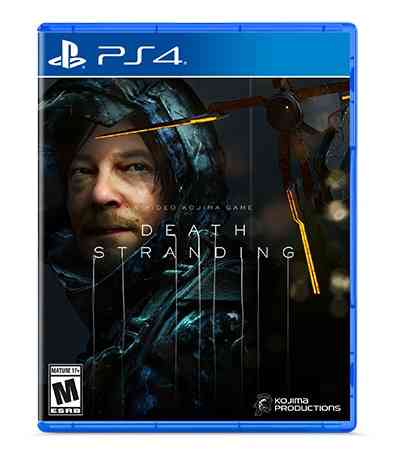Death Stranding – Neither Dead, Nor Stranded
If you’re an auteur, you define genres. You set trends, push boundaries. Every project challenges expectations. What happens when your life’s work is ripped from you? What do you do when Metal Gear is taken from you? If you’re Kojima-san, you do the only thing you know how. You make something daring. Bold. Risky. You ignore expectations, and make something that changes the rules. You make Death Stranding.
Since being revealed in 2016, Death Stranding has undoubtedly been the most mysterious project in gaming. Kojima’s split from Konami was ugly and tight lipped, yet Sony was quick to back the newly formed Kojima Productions. Free from the shackles of Konami and the Metal Gear franchise, the industry was ready for Kojima unchained. Miraculously, Death Stranding is here. No delays, no shenanigans. And after 50+ hours, I might even understand what happened.
*This article discusses the world and story of Death Stranding, but great pains were taken to avoid spoilers. However, if you’re sensitive to such things, tread lightly.*
Death Stranding is a story about connection. Creating strands between people and places. Coping with loss and building atop the ruins. It’s a big, meaty idea with plenty of dire circumstances, but it’s somehow a much more personal tale than Kojima has told before. Solid Snake was a protagonist with a personal stake in things, but Death Stranding’s narrative has a duality of meaning that’s not often seen in games.
If you’re a veteran of Hideo Kojima’s work, you’re already familiar with how Death Stranding is written. Long conversations, big info dumps, and more than enough lore to make everything believable. It’s seemingly needlessly descriptive in places, but weird specificity is part of why Kojima’s stories grab attention. Death Stranding grapples with huge themes like loss and connection, and Sam himself is an allegorical device in service to those themes.

Death Stranding is audacious, but not because it goes too far. It’s mature and tactful. It feels personal, even when the world is at stake. As Sam Porter Bridges, your task is to make America whole again. By rebuilding the connections between communities, Sam works to bring together people torn apart by the Death Stranding. What you’ve seen in trailers is actually the game. Sam is a porter, and you’ll spend a lot of time delivering packages.
It’s not what I expected. For a few hours, I wasn’t actually sure I was having a good time. Don’t get me wrong, I ended up having a fantastic time. But if you’re looking for MGS6, this isn’t it.
The pace is slower and more deliberate, and requires some forethought before setting out. Mapping out routes and examining the map before choosing to leave your climbing anchors behind will save you headaches and extra miles. Along the way, there are often lost cargo containers or building materials to be found using your Odradek scanner, but actually getting them to their destination can be tricky. If you’re the determined sort, you’ll find yourself making a lot of back and forth trips simply to make people happy.
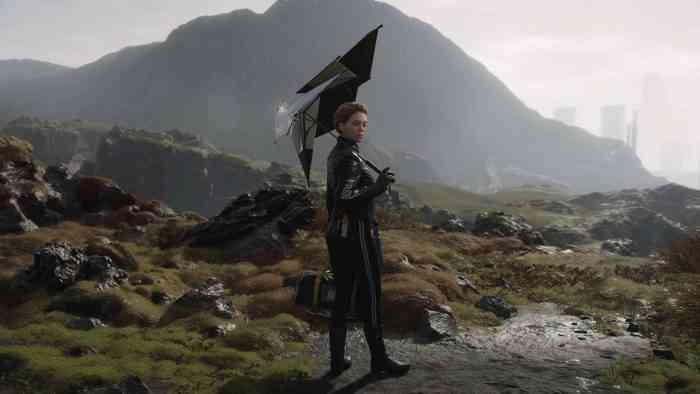
As a director, Kojima’s work has evolved right along with his storytelling. His shot selection, framing, and imagery are nothing short of brilliant. His use of angles, focus, and light is truly Hollywood quality, and mostly does away with most of the, uh, less tasteful angles of the past. Except Sam’s butt. You’ll see that a lot. Need a new wallpaper on your computer? Death Stranding is a wallpaper generation engine, and I was constantly hammering the share button to capture it all.
This is far from the wackiest thing Kojima has put out, but there are still plenty of grin worthy moments where the fourth wall is broken, or there’s a call back to Metal Gear or gaming more generally.
So Pretty It Hurts
This game is ridiculously pretty. I remember the first few shots they showed of it – I knew there was no way it’d release on PS4. Kojima, for one, but it also looked way too good. The environments are stunning. Many areas look very alien, with bizarre rocky outcrops or unnatural colors, but they feel real. Like I could take an exotic trip and see those exact landscapes. If there’s a game out there with more photorealistic scenery, I can’t name it.
The characters are equally impressive across the board. The render of Norman Reedus is as pristine as I’ve seen a model be, both still and in motion. Tiny muscle movements are flawlessly rendered, from minute mouth movements to subtle facial deformation and seamless appearance of wrinkles. If you were playing poker against one of these characters, the rendering would be granular enough to pick up on their tells. Not every conversation is a full cutscene though, and the vast majority are more of the talking head variety. In these interactions, the animation is much less advanced, and even the lip syncing is a little off in places. The quality of the voice acting is excellent though, and it’s miles better than an endless list of cassette tapes to listen to.
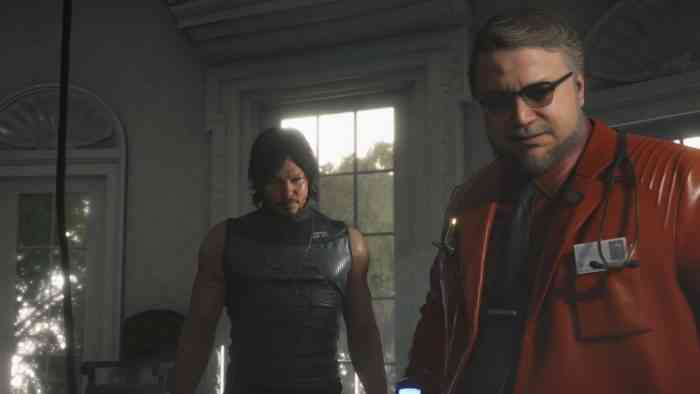
On the subject of acting, having A list actors on board is revolutionary. Mads Mikkelson is an obvious bright spot, with beautiful delivery that oozes emotion. His work elevates the other, already impressive performances too. Scenes with Mads and other characters are some of the best in the game. If you’ve seen The Walking Dead, you’ll have an idea of Norman Reedus’ performance. Far from phoned in, he puts a ton of feeling into his delivery and I was rooting for Sam right away.
All the performances had me feeling the feels along the way, but Tommie Earl Jenkins, Margaret Qualley, and Lea Seydoux are especially good, each of their characters having multiple Oscar clip moments.
On the gameplay animation side of things, things are great most of the time. Sam responds to the terrain believably, placing his feet where you’d expect flowing between animations with no perceptible seam. What really impressed me is how differently Sam would behave on different surfaces, or at different angles. If the animation is all canned, there must be a massive number of them. At times though I’d get caught up on a rock that I shouldn’t, or slip down a slope for no real reason, but those situations were rare.
Everything runs on Guerilla Games’ Decima engine, locked in at 30fps on PS4 Pro. Things have been substantially massaged to feel a bit more like MGSV, but when Sam creeps through tall grass or has a strange interaction with a rock, the bones of Horizon: Zero Dawn show through a little.
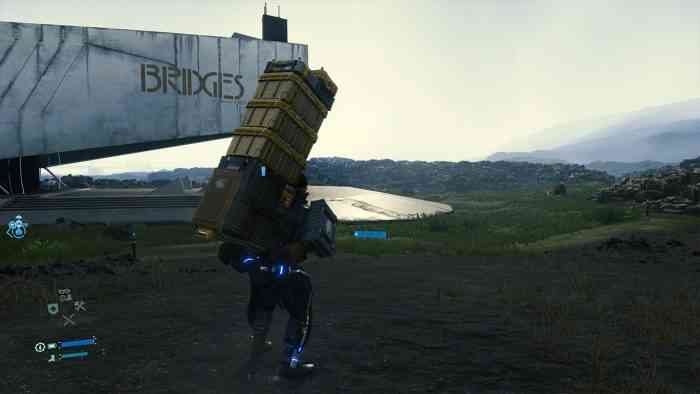
Sam is relatively agile, but his ability to maneuver steadily declines as you load up. Balancing is a constant concern, especially early on, and being too ambitious resulted in many suboptimal deliveries. Stack your pack too high, and you’ll be both slower and more unstable, weaving from side to side and liable to tumble. Though frustrating at first, I found managing Sam’s position quite relaxing once I’d picked up on his subtle cues that he was about to tip. Porters are graded and awarded likes based on how well they meet the delivery conditions. Sometimes a package is fragile, or urgent, and exceeding expectations will net more likes. The likes then funnel into buckets and level up Sam’s ability to manage unruly loads or carry additional weight among other things. That all contributes to your public facing Porter Level, which is more a badge of honor than anything.
Getting likes from people and communities fuels Death Stranding’s gear system too. Stronger connections encourage folks to share tech with Sam. From more durable footwear to floating cargo carriers, there’s a good variety of gear to utilize. Nothing quite as insane and awesome as the rocket fist from MGSV, but like I said, this isn’t Metal Gear.
Metal Gear?! No, Not At All
You’ll notice I haven’t talked about combat yet. The game really isn’t about that, but yes, there is some in Death Stranding. Strewn about the map are MULEs, former porters now obsessed with the concept of delivery, and terrorists, who just want to shoot you. Usually, just avoiding them is best, but Sam is capable of sneaking, stealth takedown-ing, and punch-punch-kicking if needed. It’s serviceable, but I missed the engagement variety of The Phantom Pain. Thankfully, shooting feels pretty good, with enough weight to feel substantial.
One of the times you’ll often want to take the avoidance route, is when the BTs show up. Invisible to the naked eye, Sam can use his Bridge Baby (BB) to detect and avoid or engage BTs. Rainfall is a dead giveaway that BTs are nearby, and I tended to slow down anytime it was raining to prepare. Of course, the rain damages your packages, so it’s a risk to go slow too. Yet another example of balancing tradeoffs.
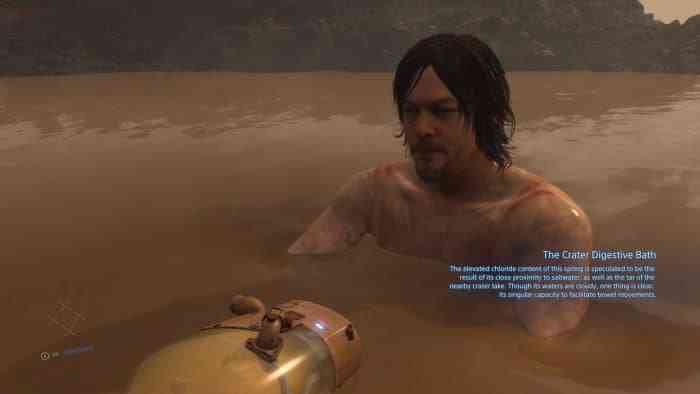
Being in the presence of BTs was initially terrifying. I grew more comfortable over time, but they always brought moments of tension to my sessions. If you get caught by BT, the chase is on. They’ll pursue Sam, trying to drag him into the dark abyss. It’s not a game over situation, but let’s just say that it has consequences for both your cargo, and the world at large.
Kojima has been long known for unorthodox boss battles, with highlights like Revolver Ocelot in Metal Gear Solid and The End in Snake Eater. Though there are some interesting situat ions, I never felt they reached the heights I wanted them to. Part of that is that the game skews toward easy, and part is that the concept of the game actively leans away from combat. They’re in there, and they’re fun, but they feel like a concession to game design than something that needs to be there.
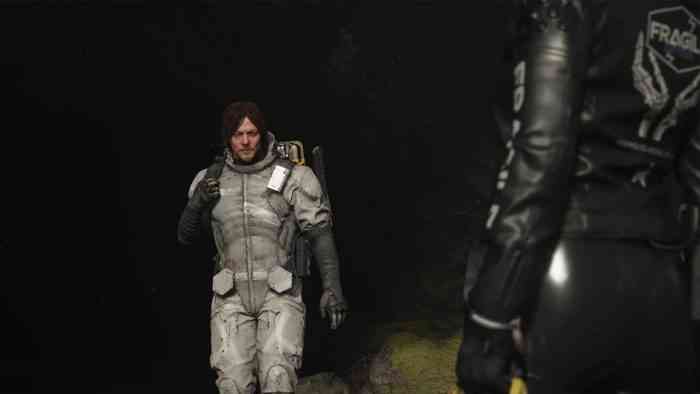
Death Stranding is an online game too, and even though you’ll never see other players, there’s a lot of opportunity for connection. Using your PCC (Kojima still loves acronyms), you can build a bunch of different structures in the world. Things like bridges, postboxes, and other fun stuff I won’t spoil. Once completed, those structures will show up in other players’ worlds. Somehow, it works absolutely seamlessly. Things I built obviously persisted in my world, but things put in place by others were equally consistent.
For example, I cut through a mountain pass on one delivery, making it through because of a well placed ladder. On the return trip, the same ladder was in the same spot, placed by the same person. I started to recognize the usernames of others, and developed an honest appreciation for their cleverly positioned structures. That a similar group of names persisted throughout my experience was both surprising and welcome. The server went down a couple of times, and the game simply notified me I was now in offline mode. To my eye, all the structures and usernames in the world stayed put with no fuss; It made me wonder how that functions on the backend. Take note, other devs, because this online implementation is completely seamless.
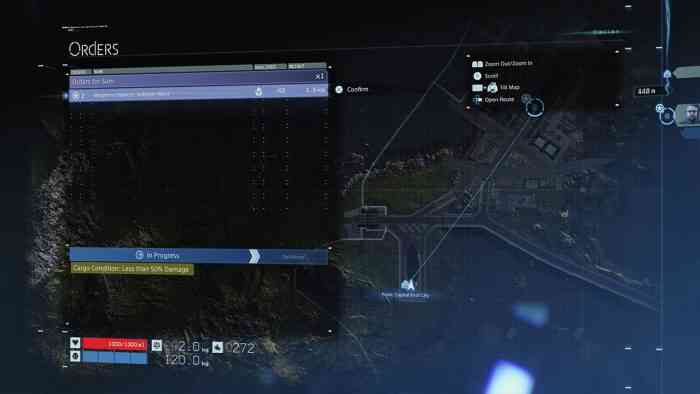
There are things that bug me though. They’re nitpicks, but they’re here. The UI is a lot to handle, there aren’t enough shortcuts for managing cargo, and some functions aren’t terribly well explained, even in the massive codex. Order management should be streamlined too, as you’ll be popping in and out of terminals multiple times to do various things.
As something I’ve been dying to understand for 3+ years, I really didn’t know what to expect from Death Stranding. What I found as I journeyed cross country with Sam Porter Bridges is a game unlike anything else I’ve played. Its central mechanic is a monotonous, everyday piece of modern life, and somehow Kojima has managed to make that a very satisfying thing to do. At times that distracted me heavily from the storyline, and I think the midgame would have been more compelling if the story beats popped up more frequently. Still, the quality of the narrative is undeniable. Death Stranding is an outstanding title that ended up blowing away the expectations I wasn’t even aware of. For an auteur like Hideo Kojima, that sounds like an unequivocal success.
**Review copy provided by Sony Interactive Entertainment**
The Good
- Incredible visual fidelity
- Masterful direction
- Outstanding cast and acting
The Bad
- May not be for everyone
- Some rough edges
- Not Metal Gear
